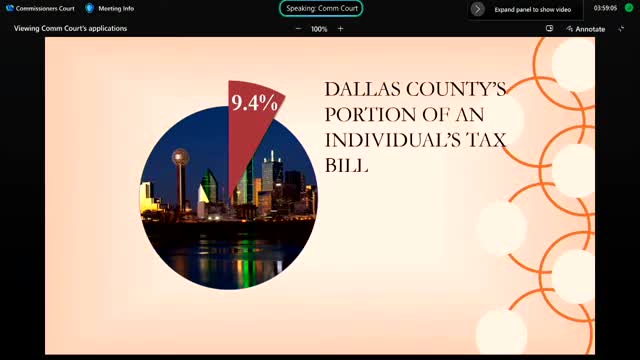Budget Talks Spark Heated Debate Over Spending Cuts
August 20, 2024 | Dallas County, Texas
This article was created by AI summarizing key points discussed. AI makes mistakes, so for full details and context, please refer to the video of the full meeting. Please report any errors so we can fix them. Report an error »

During a recent government meeting, officials engaged in a detailed discussion regarding the proposed budget and tax rates for the upcoming fiscal year. The conversation highlighted the complexities of budget planning, including the implications of various tax rates and the need for departmental evaluations.
Dr. Watkins presented several tax rate options, including a proposed rate that is conservatively set below the maximum allowable rate of 0.215,548. This approach aims to ensure that the budget aligns with actual needs rather than simply maximizing revenue. The discussion emphasized the importance of evaluating departmental performance and right-sizing operations to enhance efficiency without reducing funding for essential services.
Commissioners debated the concept of \"right-sizing,\" with some expressing confusion over its meaning. The proposal included conducting performance evaluations to identify underperforming individuals within departments, rather than eliminating positions outright. This sparked a dialogue about the challenges of civil service regulations and the need for a thorough analysis of departmental functions to identify potential savings.
A significant point of contention arose around the county's overtime budget, which has seen substantial increases in recent years. Officials noted that while the proposed budget includes a $15 million allocation for overtime, the previous year’s spending reached $35 million. Concerns were raised about the sustainability of such expenditures and the necessity of exploring cost-saving measures across departments.
The meeting also touched on the importance of maintaining the county's bond rating and ensuring financial stability amid potential state funding cuts. Officials acknowledged the need for a strategic approach to budgeting that balances operational needs with fiscal responsibility.
As the meeting concluded, there was a consensus among commissioners to further explore opportunities for savings and efficiency improvements in the upcoming budget discussions. This collaborative approach aims to ensure that taxpayer dollars are utilized effectively while maintaining essential services for the community.
Dr. Watkins presented several tax rate options, including a proposed rate that is conservatively set below the maximum allowable rate of 0.215,548. This approach aims to ensure that the budget aligns with actual needs rather than simply maximizing revenue. The discussion emphasized the importance of evaluating departmental performance and right-sizing operations to enhance efficiency without reducing funding for essential services.
Commissioners debated the concept of \"right-sizing,\" with some expressing confusion over its meaning. The proposal included conducting performance evaluations to identify underperforming individuals within departments, rather than eliminating positions outright. This sparked a dialogue about the challenges of civil service regulations and the need for a thorough analysis of departmental functions to identify potential savings.
A significant point of contention arose around the county's overtime budget, which has seen substantial increases in recent years. Officials noted that while the proposed budget includes a $15 million allocation for overtime, the previous year’s spending reached $35 million. Concerns were raised about the sustainability of such expenditures and the necessity of exploring cost-saving measures across departments.
The meeting also touched on the importance of maintaining the county's bond rating and ensuring financial stability amid potential state funding cuts. Officials acknowledged the need for a strategic approach to budgeting that balances operational needs with fiscal responsibility.
As the meeting concluded, there was a consensus among commissioners to further explore opportunities for savings and efficiency improvements in the upcoming budget discussions. This collaborative approach aims to ensure that taxpayer dollars are utilized effectively while maintaining essential services for the community.
View full meeting
This article is based on a recent meeting—watch the full video and explore the complete transcript for deeper insights into the discussion.
View full meeting
